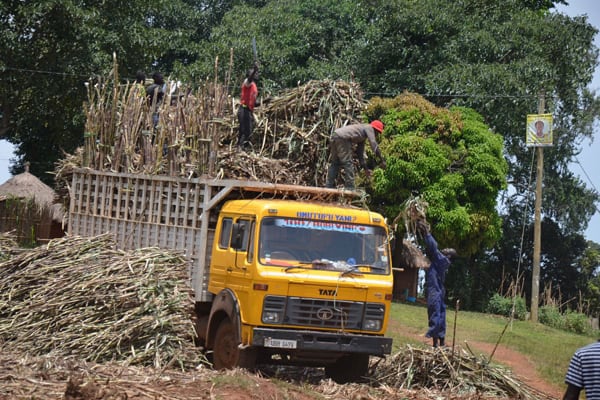Prime
Why sugarcane growing has kept Busoga poorer

Sugarcane being loaded into a truck in Jinja District in 2021. Experts have again weighed in on why Busoga Sub-region is still poverty-stricken despite engaging in sugarcane growing. PHOTO/FILE
What you need to know:
- Experts say sugarcane has only boosted incomes for those growing it on a large scale, but the majority of the locals own less than three acres of land.
Stakeholders are suggesting a direct link between the sugar industry and poverty in Busoga Sub-region.
The experts claim that the sweetener has not transformed livelihoods despite farmers engaging in the cash crop for close to 95 years.
Figures from the Uganda Bureau of Statistics (Ubos) obtained in 2020 show that Busoga has about 1.2 million poor persons of which 0.4 million are living in food poverty.
Prof Frank Nabwiso, the former MP for Kagoma, says currently, a tonne of sugarcane costs Shs220,000, which puts a kilogramme of sugarcane at Shs220.
“Sugarcane is a very cheap cash crop in Uganda and the whole of Africa. For a parent to buy a pen for a child, they have to sell two kilogrammes of sugarcane which costs Shs220. It is as bad as that and it is a very hopeless cash crop,’’ he said in an interview at the weekend.
Prof Nabwiso notes that people with small pieces of land are also in the sugarcane growing business, which he says has escalated poverty in the (Busoga) Sub-region.
“Families in Busoga have given away their small pieces of land for sugarcane cultivation yet it is only benefiting those with huge chunks of land. It is labour intensive, you have to wait for eighteen months and have to use manual labour. It has little profit,” he said.
According to Prof Nabwiso, sugarcane growing started in 1928 after then Governor, Sir William Growers, parceled out chunks of land in Busoga under the Imperial British Crown Land to the Muljibhai Madhvani Group of Companies for sugarcane farming.
The director of Makerere University Business School Economic Forum, Mr Fred Muhumuza, says history has shown that growing sugarcane has not lifted majority of the Basoga out of poverty.
“Sugarcane has only helped those who are growing sugarcane on a large scale; so, it has only benefited the minority. It cannot be an answer to the majority of the people because Ubos statistics indicate that 70 percent of Ugandans have less than three acres of land and most of them are in different areas,’’ he says
Mr Muhumuza, an economist, urges people of Busoga to engage in income-generating ventures that yield high output per acre, for example, onions and carrots farming, poultry, and livestock.
The senior presidential adviser on poverty alleviation in Busoga, Ms Florence Mutyabule, says sugarcane growing cannot be a solution for an ordinary person.
Ms Mutyabule suggestes that for poverty to be eradicated in Busoga, the mindset of cultivating one perennial crop must stop.
‘‘For one to benefit from sugarcane growing, one must have 10 acres of land and above, but there is also a lot of land fragmentation in Busoga, with most people now looking for money to buy food because they rent out their one-acre piece of land for sugarcane growing,’’ she said.
Cooperatives
Ms Mutyabule suggested that joining cooperatives raises the bargaining power of locals engaged in production.
Former Agriculture minister Victoria Ssekitoleko says sugarcane growing has left many households in poverty.
Ms Ssekitoleko, who was a former representative of the Food and Agriculture Organisation in China, South Africa and Ethiopia to the African Union, asks farmers to engage in government projects that are ongoing in Busoga, including Parish Development Model (PDM) and Emyooga among others.
“We have farmers in Bugiri District who are currently engaging in growing jackfruit on 500 acres of land for export. We have Kasolwe breed livestock for distribution (Kasolwe Stock Farm) in Kamuli District; we want many farmers to embrace such projects because their market is guaranteed,’’ she said.
Millers speak out
The chairperson of Uganda Sugar Manufacturers Association, Mr Jim Kabeho, said sugarcane growing can eradicate poverty in Busoga Sub-region if farmers are well organised.
“As millers, we pay a lot of money to farmers in the sub-region, but they need to do smart farming so that they can increase the yields,” Mr Kabeho said, adding that farmers also need to look after the sugarcane in order to get high yields per acre.
Currently, he said, farmers are getting 60 tonnes of sugarcane per acre yet they are supposed to get more than 100 tonnes.
The chairperson of Busoga Sugarcane Growers Association, Mr Abubaker Omboko, says farmers only need support from the government so that they can grow more sugarcane and become richer.
“The government can, for instance, deduct some money from the Shs400b it receives from the sugar millers in taxes every year and purchase tractors for the farmers.
Mr Godfrey Naitema, a farmer, says sugarcane has brought “wealth” among people in Busoga, adding that farmers have been able to provide education to their children. He also hailed sugarcane as a drought-resistant crop unlike others such as coffee.




